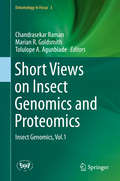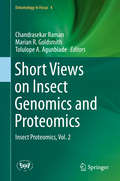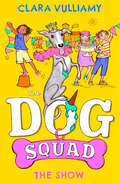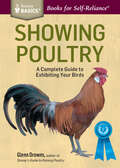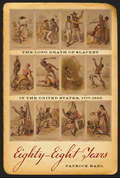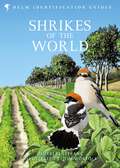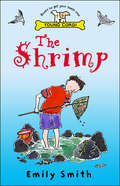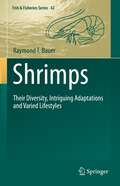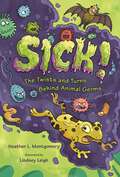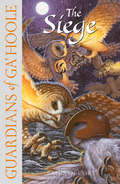- Table View
- List View
A Short History of the World in 50 Animals (A Short History of the World #2)
by Jacob F. FieldA Short History of the World in 50 Animals provides a new perspective on the grand sweep of our planet’s making, taking readers from the time of the dinosaurs to the time of Dolly, the first cloned mammal. This book will include a great variety of beasts from across the animal kingdom, some well known and others far more surprising, from every continent in the world. Each entry will show the creature’s influence on world development, economy, health, culture, religion and society. The size of the animals range from hulking elephants to tiny bees but each one has made a significant impact on history.A Short History of the World in 50 Animals details the impact, legacy and role of fifty animals that determined the world’s history and shows how many of them are essential for our future survival. Featuring charming black and white illustrations throughout, which celebrate these extraordinary animals.In the same series: A Short History of the World in 50 Places.
A Short Philosophy of Birds
by Philippe J. Dubois Elise RousseauThe greatest wisdom comes from the smallest creaturesThere is so much we can learn from birds. Through twenty-two little lessons of wisdom inspired by how birds live, this charming french book will help you spread your wings and soar.We often need the help from those smaller than us. Having spent a lifetime watching birds, Philippe and Élise – a French ornithologist and a philosopher – draw out the secret lessons that birds can teach us about how to live, and the wisdom of the natural world. Along the way you’ll discover why the robin is braver than the eagle, what the arctic tern can teach us about the joy of travel, and whether the head or the heart is the best route to love (as shown by the mallard and the penguin). By the end you will feel more in touch with the rhythms of nature and have a fresh perspective on how to live the fullest life you can.
Short Views on Insect Genomics and Proteomics: Insect Genomics, Vol.1 (Entomology in Focus #3)
by Chandrasekar Raman Marian R. Goldsmith Tolulope A. AgunbiadeEntomology as a science of inter-depended branches like molecular entomology, insect biotechnology, has made rapid progress. This also implies that there is an urgent need to manage the available resources. In the past five decades, entomology has taken giant steps ahead. The aim of this work is to integrate perspectives across molecular and biochemistry, physiology, reproduction, developmental biology, molecular evolution, genetics and RNAi applications. This century is proclaimed as the Era of Biotechnology and it consists of all types of Mol-Bio-Gen applications, which is an essential component for a thorough understanding of the insect biology. The aim of this work is to provide the comprehensive review of recent research from various geographic areas around the world and contributing authors that are recognized experts in their respective field of Genomic entomology. This Volume emphasizes upon the need for and relevance of studying molecular aspects of entomology in Universities, Agricultural Universities and other centers of molecular research. It will also serve as a landmark source for Insect advance science technology.
Short Views on Insect Genomics and Proteomics: Insect Proteomics, Vol.2 (Entomology in Focus #4)
by Chandrasekar Raman Marian R. Goldsmith Tolulope A. AgunbiadeEntomology is a super science, embracing interdisciplinary approaches in genomics, proteomics, and interdependent fields of biochemistry, physiology, molecular entomology, and biotechnology. An urgent need to manage available resources for the benefit of the planet and humankind has led to remarkable progress since publication of the fruit fly genome in 2000. “Short Views on Insect Genomics and Proteomics” presents multiple perspectives of recognized experts from around the world in genomics, bioinformatics, molecular biology, biochemistry, physiology, and immunology, emphasizing fast-moving areas of current research on insects and other arthropods. Concise, accessible, topical reviews include body lice and white fly genome projects, aphid phenotypic plasticity, insect regulatory genomics, the complex tick sialome, protein expression systems, therapeutic potential of insect antimicrobial peptides, nanoparticle insecticides, and novel uses for recombinant and synthetic spider silks.
The Show (The Dog Squad #3)
by Clara VulliamyMeet Eva, Simone and Ash: best friends, budding journalists, and the stars of this delightful new series about family, friends, and DOGS, from the author of the much-loved MARSHMALLOW PIE and DOTTY DETECTIVE books!
Showing Poultry: A Complete Guide to Exhibiting Your Birds. A Storey BASICS® Title (Storey Basics)
by Glenn DrownsThis addition to the Storey BASICS farming line is for the thousands of people raising chickens and other poultry who want to take the next challenge: exhibiting their birds in shows small and large, whether urban, suburban, or rural.
Showing Your Dog: A Beginner's Guide
by Elaine EverestCompeting at dog shows is an excellent way for the family - both young and old alike - to enjoy a hobby together. Many people enter this sport first with a family pet as a fun day out and then move on to more serious competition at championship level. The ultimate goal for most newcomers is to qualify for Crufts and perhaps even win the much coveted Best in Show award. This book takes you step by step through the process of what is required to enjoy showing a dog. It will tell you: - How to choose a good quality pedigree puppy and understand its health requirements - How to train and prepare from day one through to that first dog show - How to enter a show and what to expect - Where to go and when at the dog show, and what to do in the show ring - What clubs, committees and support are available for the novice exhibitor - How to qualify for Crufts and what to expect upon arriving at the World's Greatest Dog Show - What the next step is and whether to purchase another dog, breed a litter or even train to be a judge.Contents: Acknowledgements; Introduction; 1. Starting out; 2. Learning to Show 3. Grooming and Presentation; 4. Entering a Show; 5. Travelling with Dogs; 6. The Day of the Show; 7. Rules and Etiquette; 8. Awards and Prizes; 9. Major Champonship Shows; 10. What Next?; The Rainbow Bridge; Glossary; Useful Information; Index.
Showjumpers (Pony Club Rivals #2)
by Stacy GreggThe stakes are raised in the second book of this glamorous horse riding series set in the USA – winner takes all as the rivals compete for the showjumping cup! Don’t miss the latest instalment of pony adventures from the author of the UK’s bestselling pony series ‘Pony Club Secrets’.
Shredder
by Jonathan KebbeShredder is the class gerbil - and he has an amazing ability to shred his way through anything! Shredder's best friend in the class is Dino, a rather naughty boy who gets blamed for everything. When Shredder escapes from his cage and makes his way into the box where the money for the class trip is being kept, disaster strikes - and Dino gets the blame!
Shrikes (Helm Identification Guides)
by Norbert Lefranc Tim WorfolkShrikes are a charismatic group of birds occurring throughout most of the Old World and North America. The family Laniidae consists of 31 species in three genera, if the Southern Grey Shrike and Great Grey Shrike are accepted as separate species which the author recommends. This book is the first to cover all the shrikes in one volume. Shrikes because of their habit of impaling their prey on the thorns of bushes, were known in the countryside as 'butcher-birds' and, indeed, their Latin name lanius means butcher. They are small to medium-sized birds. The smallest, Emin's Shrike which occurs in central Africa, is about the size of a House Finch or Greenfinch, and the largest is the Chinese Grey Shrike. One of their most striking features is their raptor-like hooked bill. Another typical feature is their face mask which gives them the look of small, fierce highwaymen. Many species are of conservation concern including the Great Grey Shrike, The Lesser Grey Shrike, The Woodchat Shrike and the Red-backed Shrike in Europe and the Loggerhead Shrike in North America. The decline of these species has been largely caused by changing farming methods, but all are now legally protected. This brilliant book brings together the most recent information on the shrike family and the superb text and illustrations should lead to successful and safe identification of all species in the field.
Shrikes: A Guide To The Shrikes Of The World (Helm Identification Guides)
by Norbert Lefranc Tim WorfolkShrikes are a charismatic group of birds occurring throughout most of the Old World and North America. The family Laniidae consists of 31 species in three genera, if the Southern Grey Shrike and Great Grey Shrike are accepted as separate species which the author recommends. This book is the first to cover all the shrikes in one volume. Shrikes because of their habit of impaling their prey on the thorns of bushes, were known in the countryside as 'butcher-birds' and, indeed, their Latin name lanius means butcher. They are small to medium-sized birds. The smallest, Emin's Shrike which occurs in central Africa, is about the size of a House Finch or Greenfinch, and the largest is the Chinese Grey Shrike. One of their most striking features is their raptor-like hooked bill. Another typical feature is their face mask which gives them the look of small, fierce highwaymen. Many species are of conservation concern including the Great Grey Shrike, The Lesser Grey Shrike, The Woodchat Shrike and the Red-backed Shrike in Europe and the Loggerhead Shrike in North America. The decline of these species has been largely caused by changing farming methods, but all are now legally protected. This brilliant book brings together the most recent information on the shrike family and the superb text and illustrations should lead to successful and safe identification of all species in the field.
Shrikes and Bush-shrikes: Including Wood-shrikes, Helmet-shrikes, Shrike Flycatchers, Philentomas, Batises and Wattle-eyes (Helm Identification Guides)
by Tony HarrisCovering the identification, biology and relationships of all true shrikes, bush-shrikes, helmet-shrikes, wood-shrikes, shrike flycatchers, philentomas, batises and wattle-eyes this book offers information on 114 species in 21 genera within the families Laniidae and Malaconotidae. For each genus, acoustic and visual signals are summarized and used to map similarities.The detailed species account for the bulk of the book, providing knowledge on field identification, plumage descriptions, geographical variation, moult, distribution, movements. general and foraging behaviour, food, sounds and breeding behaviour."
Shrikes of the World
by Norbert Lefranc'This long-awaited update to the acclaimed first edition is the definitive guide to a complex and intriguing family. The species accounts and taxonomic treatments have been fully revised in line with recent studies, and the all-new plates and photos complete this remarkable work. Highly recommended.' – Dominic MitchellBeautiful, colourful, often fearless hunters of large insects and small vertebrates, shrikes are among the most admired of all avian groups. The group is widespread (particularly in the Old World) with a large number of species, though many populations have plummeted in recent years, especially in Europe.This is a second edition of Norbert Lefranc's Shrikes, fully updated from its 1997 predecessor. The introductory texts have been significantly expanded and six new sections have been added in the species accounts: vagrancy, foraging behaviour, breeding success, population trends, conservation and taxonomic notes. Special attention has been given to the latest developments in shrike systematics, not forgotten by the DNA revolution. The speciesaccounts give information about the past and current distribution, along with threats and conservation status. Detailed and fully revised maps accompany the authoritative text, along with hundreds of high-quality photos showcasing racial and ageing differences as well as interesting aspects of shrike behaviour. An exceptional new series of plates by Tim Worfolk have been created, with more individual plumages shown than in the previous edition.This beautiful book represents the definitive account of shrikes and their relationships, appearance, conservation and lifestyle; it will be treasured by birdwatchers and professional ornithologists alike.
Shrikes of the World
by Norbert Lefranc'This long-awaited update to the acclaimed first edition is the definitive guide to a complex and intriguing family. The species accounts and taxonomic treatments have been fully revised in line with recent studies, and the all-new plates and photos complete this remarkable work. Highly recommended.' – Dominic MitchellBeautiful, colourful, often fearless hunters of large insects and small vertebrates, shrikes are among the most admired of all avian groups. The group is widespread (particularly in the Old World) with a large number of species, though many populations have plummeted in recent years, especially in Europe.This is a second edition of Norbert Lefranc's Shrikes, fully updated from its 1997 predecessor. The introductory texts have been significantly expanded and six new sections have been added in the species accounts: vagrancy, foraging behaviour, breeding success, population trends, conservation and taxonomic notes. Special attention has been given to the latest developments in shrike systematics, not forgotten by the DNA revolution. The speciesaccounts give information about the past and current distribution, along with threats and conservation status. Detailed and fully revised maps accompany the authoritative text, along with hundreds of high-quality photos showcasing racial and ageing differences as well as interesting aspects of shrike behaviour. An exceptional new series of plates by Tim Worfolk have been created, with more individual plumages shown than in the previous edition.This beautiful book represents the definitive account of shrikes and their relationships, appearance, conservation and lifestyle; it will be treasured by birdwatchers and professional ornithologists alike.
The Shrimp
by Emily SmithBen spends the holidays with his nose in the sand and bottom in the air. It's not because he's shy - though some of his classmates do call him the Shrimp. It's because he's got a great idea for his wildlife project.A competition is on! The class projects are going to be judged by a famous TV wildlife presenter, and the prize is irresistible. Ben would love to win it, but others have their eyes on the prize too...
Shrimps: Their Diversity, Intriguing Adaptations and Varied Lifestyles (Fish & Fisheries Series #42)
by Raymond T. BauerThis book explores the biology of decapod shrimps, a group of animals known to most people as a nutritious and tasty food item. Shrimps are amazingly diverse in size, shape, coloration, behavior and natural history. Shrimp fisheries and aquaculture are a vital part of the USA and world economies. These crustaceans are key ecological and food-web components of marine and freshwater habitats. The book synthesizes information on the taxonomic and ecological diversity of shrimps, the structure and function of shrimp anatomy, antifouling adaptations, coloration and camouflage, reproductive biology, sexual systems, mating systems and behavior, life history strategies, symbioses between shrimps and other organisms, shrimp fisheries and aquaculture, as well as the evolution and phylogeny of shrimps. All chapters are written within an adaptational and evolutionary perspective. Important questions about shrimp biology are asked, and hypotheses for testing in future research are proposed. The book is spiced up with personal anecdotes and observations from the author’s research experiences. This book is intended as a comprehensive reference, a “go to” book about the biology of shrimps. The text is scientifically rigorous but written in a style intended for a varied readership. Thus, the book is a valuable resource for budding or working research scientists such as zoologists, aquatic biologists, fisheries and aquaculture professionals, as well as amateur naturalists, aquarium hobbyists and interested laypersons. As the saying goes, “a picture is worth a thousand words,” so that the book is amply illustrated with figures and diagrams.The numerous color plates, composed of photos contributed by expert colleagues, make the world of shrimps come alive.
Shumba's Big Adventure: (early Reader) (Early Reader)
by Lauren St JohnEarly Readers are stepping stones from picture books to reading books. A blue Early Reader is perfect for sharing and reading together. A red Early Reader is the next step on your reading journey.Shumba is the naughtiest lion cub in the whole of Africa. When he sneaks off one night to go exploring, he finds himself on a boat going all the way to England with gorillas, snakes, monkeys, zebras and parrots. And that's just the start of his adventure! A heartwarming Early Reader story from the author of the White Giraffe quartet, which brings Africa and its animals to life for the youngest readers.
Siberian Huskies For Dummies (For Dummies Ser.)
by Diane MorganBred for loyalty, strength and endurance, the easy-going and sociable Siberian Husky is a very pure and ancient breed, dating back 4,000 years or more. First bred by the Chukchis, a semi-nomadic people of northeastern Siberia, to hunt reindeer and pull sleds, the Siberian is an active breed that loves the outdoors. Prized for their great beauty, intelligence, wonderful way with children and lack of “dog smell,” they are also more free-spirited (and free-ranging) than many other popular breeds, and have a reputation for stubbornness and relentlessness in pursuit of a goal. Is this breed right for you and your family? Siberian Huskies For Dummies answers this and all your questions about getting, caring for and living with a Husky. Siberian devotee—she has eight of her own—Diane Morgan gets you up and running with what you need to know to: Find and deal with reputable breeders Choose the right Husky for you Hou sebreak and socialize your new puppy Educate yourself and your dog Handle behavioral problems Participate in competitions In friendly, down-to-earth language, Diane provides insights into the Siberian Husky temperament and loads of sensible, easy-to-follow advice on everything a Husky owner should know—along with fun facts and Husky trivia, amusing and informative anecdotes, and tips on how to have a great time with your Husky. Topics covered include: Understanding what makes the Siberian different from every other breed Deciding whether a male or female is right for you Understanding how to communicate with your Siberian Husky Training your Siberian Husky Grooming your Siberian Finding and establishing a good relationship with a veterinarian Breaking bad habits in your Husky Feeding and exercising your Siberian Husky Recognizing, preventing and treating common health problems Getting your Husky into sledding The indispensable guide for you and your Siberian Husky, Siberian Huskies For Dummies is the only book you’ll need to help you have the best possible experience with this very ancient and venerable breed of dog.
Siberian Huskies For Dummies
by Diane MorganDiscover how to raise, train, and enjoy your Siberian Husky with this fantastic resource The Second Edition of Siberian Huskies For Dummies offers the most up-to-date information about welcoming a Siberian Husky into your home and loving your new family member. Author and Husky owner Diane Morgan walks you through how to care for these beautiful, curious, and engaging dogs, as she: Suggests ideal methods for adopting and selecting a Husky right for you Examines ways to socialize your new Husky Shares details about Siberian Husky grooming and veterinary care Provides additional information about behavior correction and training Siberian Huskies For Dummies is packed full of practical tips about how to raise and have fun with your young or old Siberian Husky. The author shares her advice in plain English for people looking for accessible and approachable information. Perfect for new and experienced husky owners, Siberian Huskies For Dummies also belongs on the bookshelves of anyone who’s ever considered adopting one of these magnificent animals.
Siberian Huskies For Dummies (For Dummies Ser.)
by Diane MorganDiscover how to raise, train, and enjoy your Siberian Husky with this fantastic resource The Second Edition of Siberian Huskies For Dummies offers the most up-to-date information about welcoming a Siberian Husky into your home and loving your new family member. Author and Husky owner Diane Morgan walks you through how to care for these beautiful, curious, and engaging dogs, as she: Suggests ideal methods for adopting and selecting a Husky right for you Examines ways to socialize your new Husky Shares details about Siberian Husky grooming and veterinary care Provides additional information about behavior correction and training Siberian Huskies For Dummies is packed full of practical tips about how to raise and have fun with your young or old Siberian Husky. The author shares her advice in plain English for people looking for accessible and approachable information. Perfect for new and experienced husky owners, Siberian Huskies For Dummies also belongs on the bookshelves of anyone who’s ever considered adopting one of these magnificent animals.
The Siberian Sturgeon (Acipenser baerii, Brandt, 1869) Volume 1 - Biology
by Patrick Williot Guy Nonnotte Denise Vizziano-Cantonnet Mikhail ChebanovThe biology of the Siberian sturgeon, Acipenser baerii Brandt 1869, has become a very attractive subject of investigation for biologists since the 1980s. This volume 1 is part of a two-volume set devoted to the species, the second of which focuses on farming. The present volume is divided into three parts: Biology and ecology, Biology and physiology of reproduction, and Ecophysiology, i.e. adaptation to the environment. The first part addresses a broad range of topics, such as: the ecology, including a new approach to species-specificity, a new insight on the mineralization of vertebral elements, two approaches to sex determination, transposable elements in the gonads, early ontogeny, olfaction and gustation, nutrition and swimming. The second part includes neurochemical and anatomical descriptions of the central nervous system and an updated version of the oogenesis, the characteristics of both sperm and spermatozoa, and a synthesis on gonadal steroids (synthesis, plasmatic levels and biological activities). In turn, the third part reveals how the physiology of the species changes depending on environmental factors such as oxygen, ammonia, and nitrite. Some fundamental consequences of ammonia are developed (sublethal and lethal levels, effects on gill epithelium and haematology, acid-base balance, on AA and adenyl nucleotides levels in plasma, brain and muscle tissue). In addition, the book includes two methodological chapters dealing with fish dorsal aortic cannulation and respiration physiology.
The Siberian Sturgeon (Acipenser baerii, Brandt, 1869) Volume 2 - Farming
by Patrick Williot Guy Nonnotte Mikhail ChebanovThe Siberian sturgeon, Acipenser baerii Brandt 1869 is the most widely farmed sturgeon species. Continuing from Volume 1, which focuses on the biology of the species, the present Volume 2 in turn examines farming aspects. It is divided into six parts, the first of which deals with reproduction and early ontogenesis, i.e. reproductive cycles, controlled reproduction, sperm cryoconservation, and weaning of larvae. The second covers the growing phase with a focus on food and feeding (management, fish meal replacement, potential endocrine disruptions, usefulness of prebiotics and immunostimulants, and nitrogen excretion). Production-related data are the focus of the third part and include: characteristics (countries, structures of production, evolution in production, economic features) of the gross production of the species (meat and caviar) worldwide, a method for assessing the quality of caviars, off-flavors management, and an example of production of fingerlings for restocking. Part four addresses selected long-term management issues: genetic variability of brood stocks, genome manipulation and sex control, and the advantages of hybrids. The next three chapters constitute the fifth part, which is devoted to health status (immunology and welfare). In closing, the absence of ecological risks of introducing the species in non-native waters is shown using two long-term documented examples (Russia and France). Three methodological chapters round out the volume, covering: in vitro incubation of ovarian follicles, a richly illustrated library of echographies and photos, and a detailed presentation of oxygen demand studies.
Sick!: The Twists and Turns Behind Animal Germs
by Heather L. MontgomeryWhen a super sickness lands on the land, when a parasite becomes more than a pest, when an infection ignites an epidemic, what's a body to do? Your body is an animal body, so why not ask the animals?Follow the scientists, around the world and into their labs, who are studying animals and the germs that attack them. From fungus-ridden frogs with fevers to bacteria-resistant buzzards and everything in-between, animals have A LOT to teach us about infections. But-reader beware!!-the story of germs is filled with twists and turns.In this fascinating, highly visual nonfiction book packed with colorful, comic-style art, you'll discover not only the cool ways that animal bodies (and our bodies) fight back against pesky pathogens, but also the amazing and surprising ways we can learn to work together with germs.Sick! The Twists and Turns Behind Animal Germs is written by Heather L. Montgomery with graphic novel-style art from Lindsey Leigh.
Sick!: The Twists and Turns Behind Animal Germs
by Heather L. MontgomeryWhen a super sickness lands on the land, when a parasite becomes more than a pest, when an infection ignites an epidemic, what's a body to do? Your body is an animal body, so why not ask the animals?Follow the scientists, around the world and into their labs, who are studying animals and the germs that attack them. From fungus-ridden frogs with fevers to bacteria-resistant buzzards and everything in-between, animals have A LOT to teach us about infections. But-reader beware!!-the story of germs is filled with twists and turns.In this fascinating, highly visual nonfiction book packed with colorful, comic-style art, you'll discover not only the cool ways that animal bodies (and our bodies) fight back against pesky pathogens, but also the amazing and surprising ways we can learn to work together with germs.Sick! The Twists and Turns Behind Animal Germs is written by Heather L. Montgomery with graphic novel-style art from Lindsey Leigh.
The Siege: The Siege (Guardians of Ga’Hoole #4)
by Kathryn LaskyFourth title in a mythic adventure series in which the heroes are owls!


